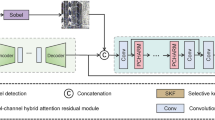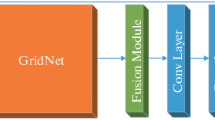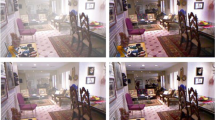Abstract
In recent years, deep learning-based methods for remote sensing image dehazing have achieved remarkable progress, especially with the incorporation of attention mechanisms to enhance feature learning. However, the channel attention method uses global average pooling to aggregate feature information, which makes it sensitive to specific points of influence. In particular, remote sensing images are captured in a wide range, and are more likely to have special points such as abrupt color changes and confusing landscapes within the images. This paper proposes a dynamic feature attention network (DFA-Net) that includes a dynamic channel module and a pixel attention module to address this challenge. The dynamic channel attention module adds a network branche to learn the weight of spatial information and dynamically aggregates features to reduce the influence from outliers such as color mutations and improve the defogging effect. The pixel attention module is also added to learn the importance of different pixels and enhance the feature extraction capability. Experiments on several datasets have shown that DFA-Net is suitable for remote sensing image dehazing in various scenes, and has achieved the best dehazing performance.





Similar content being viewed by others
References
Berman D, Treibitz T, Avidan S (2016) Non-local image dehazing. In: 2016 IEEE conference on computer vision and pattern recognition (CVPR)
Bi G, Ren J, Tianjiao F, Nie T, Chen C, Zhang N (2017) Image dehazing based on accurate estimation of transmission in the atmospheric scattering model. IEEE Photonics J 9(4):1–18
Chen D, He M, Fan Q, Liao J, Zhang L, Hou D, Yuan L, Hua G (2019) Gated context aggregation network for image dehazing and deraining. In: 2019 IEEE winter conference on applications of computer vision (WACV), pp 1375–1383
Chen X, Li Y, Dai L, Kong C (2021) Hybrid high-resolution learning for single remote sensing satellite image dehazing. IEEE Geosci Remote Sens Lett 19:1–5
Cox LJ (1977) Optics of the atmosphere-scattering by molecules and particles. Optica Acta Int J Optics 24:779–779
Dharejo FA, Zhou Y, Deeba F, Jatoi MA, Khan MA, Mallah GA, Ghaffar A, Chhattal M, Du Y, Wang X (2021) A deep hybrid neural network for single image dehazing via wavelet transform. Optik 231:166462
Dong H, Pan J, Xiang L, Hu Z, Yang MH (2020) Multi-scale boosted dehazing network with dense feature fusion. In: 2020 IEEE/CVF conference on computer vision and pattern recognition (CVPR)
Dong P, Wang B (2022) Transra: transformer and residual attention fusion for single remote sensing image dehazing. Multidimens Syst Signal Process 33(4):1119–1138
Duan Y, Luo F, Fu M, Niu Y, Gong X (2023) Classification via structure preserved hypergraph convolution network for hyperspectral image. IEEE Trans Geosci Remote Sens 61:1–3
Grohnfeldt C, Schmitt M, Zhu X (2018) A conditional generative adversarial network to fuse SAR and multispectral optical data for cloud removal from sentinel-2 images. In: IGARSS 2018-2018 ieee international geoscience and remote sensing symposium, pp 1726–1729
Gu Z, Zhan Z, Yuan Q, Yan L (2019) Single remote sensing image dehazing using a prior-based dense attentive network. Remote Sens 11(24):3008
Guo J, Yang J, Yue H, Tan H, Hou C, Li K (2020) Rsdehazenet: Dehazing network with channel refinement for multispectral remote sensing images. IEEE Trans Geosci Remote Sens 59(3):2535–2549
He K, Sun J, Tang X (2011) Single image haze removal using dark channel prior. IEEE Trans Pattern Anal Mach Intell 33:2341–2353
Hu A, Xie Z, Xu Y, Xie M, Qiu Q (2020) Unsupervised haze removal for high-resolution optical remote-sensing images based on improved generative adversarial networks. Remote Sens 12(24):4162
Jiang B, Chen G, Wang J, Ma H, Wang L, Wang Y, Chen X (2021) Deep dehazing network for remote sensing image with non-uniform haze. Remote Sens 3(21):4443
Jiang H, Ning L (2018) Multi-scale residual convolutional neural network for haze removal of remote sensing images. Remote Sens 10(6):945
Hu J, Shen L, Sun G (2019) Squeeze-and-excitation networks. IEEE Trans Pattern Anal Mach Intell 42(8):2011–2023
Kussul N, Lavreniuk M, Skakun S, Shelestov A (2017) Deep learning classification of land cover and crop types using remote sensing data. IEEE Geosci Remote Sens Lett 14(5):778–782
Li B, Peng X, Wang Z, Xu J, Dan F (2017) Aod-net: All-in-one dehazing network. In: 2017 IEEE international conference on computer vision (ICCV)
Liu Q, Gao X, He L, Wen L (2017) Haze removal for a single visible remote sensing image. Signal Process 137:33–43
Liu X, Ma Y, Shi Z, Chen J (2020) Griddehazenet: Attention-based multi-scale network for image dehazing. In: 2019 IEEE/CVF international conference on computer vision (ICCV)
Luo F, Zhou T, Liu J, Guo T, Gong X, Ren J (2023) Multiscale diff-changed feature fusion network for hyperspectral image change detection. IEEE Trans Geosci Remote Sens 61:1–13
Mehta A, Sinha H, Mandal M, Narang P (2021) Domain-aware unsupervised hyperspectral reconstruction for aerial image dehazing. In: Proceedings of the IEEE/CVF winter conference on applications of computer vision, pp 413–422
Qin X, Wang Z, Bai Y, Xie X, Jia H (2020) FFA-Net: Feature fusion attention network for single image dehazing. In: Proceedings of the AAAI conference on artificial intelligence 34:11908–11915
Qin Z, Ni L, Tong Z, Qian W (2015) Deep learning based feature selection for remote sensing scene classification. IEEE Geosci Remote Sens Lett 12:1–5
Rong Z, Jun WL (2014) Improved wavelet transform algorithm for single image dehazing. Optik 125(13):3064–3066
Shrivastava A, Jain S (2016) Single image dehazing based on one dimensional linear filtering and adoptive histogram equalization method. In: 2016 international conference on electrical, electronics, and optimization techniques (ICEEOT), IEEE, pp 4074–4078
Song Y, He Z, Qian H, Du X (2022) Vision transformers for single image dehazing. In arXiv preprint arXiv:2204.03883,
Thanh DN, Hue NM, Prasath VS (2019) Single image dehazing based on adaptive histogram equalization and linearization of gamma correction. In: 2019 25th Asia-Pacific conference on communications (APCC), pp 36–40
Yixuan T, Jia K, Wei X, Yunjun Yao M, Xia XZ, Jiang B (2020) A time-efficient fractional vegetation cover estimation method using the dynamic vegetation growth information from time series glass fvc product. IEEE Geosci Remote Sens Lett 17(10):1672–1676
Tu Z, Talebi H, Zhang H, Yang F, Milanfar P, Bovik A, Li Y (2022) Maxim: Multi-axis mlp for image processing. In: CVPR conference on computer vision and pattern recognition
Tufail Z, Khurshid K, Salman A, Nizami IF, Khurshid K, Jeon B (2018) Improved dark channel prior for image defogging using RGB and YcbCr color space. IEEE Access 6:32576–32587
Wang H, Cao H, Kai Y, Bai H, Chen X, Yang Y, Xing L, Zhou C (2022) Multi-source remote sensing intelligent characterization technique-based disaster regions detection in high-altitude mountain forest areas. IEEE Geosci Remote Sens Lett 19:1–5
Woo S, Park J, Lee JY, Kweon IS (2018) Cbam: Convolutional block attention module. In: European conference on computer vision
Xu X, Ma Y, Sun W (2020) Learning factorized weight matrix for joint filtering. In: International conference on machine learning, PMLR, pp 10587–10596
Xiangyu X, Ma Y, Sun W, Yang M-H (2020) Exploiting raw images for real-scene super-resolution. IEEE Trans Pattern Anal Mach Intell 44(4):1905–1921
Zhang L, Song L, Bo D, Zhang Y (2019) Nonlocal low-rank tensor completion for visual data. IEEE Trans Cybern 51(2):673–685
Zhang QL, Yang YB (2021) Sa-net: Shuffle attention for deep convolutional neural networks. In: ICASSP 2021-2021 IEEE international conference on acoustics, speech and signal processing (ICASSP), IEEE, pp 2235–2239
Zhang X, Wang T, Wang J, Tang G, Zhao L (2020) Pyramid channel-based feature attention network for image dehazing. Comput Vis Image Underst 197:103003
Zhao L, Tang P, Huo L (2016) Feature significance-based multibag-of-visual-words model for remote sensing image scene classification. J Appl Remote Sens 10(3):035004–035004
Zhao L, Zhang Y, Cui Y (2022) An attention encoder-decoder network based on generative adversarial network for remote sensing image dehazing. IEEE Sens J 22(11):10890–10900
Zheng M, Qi G, Zhu Z, Li Y, Wei H, Liu Yu (2020) Image dehazing by an artificial image fusion method based on adaptive structure decomposition. IEEE Sens J 20(14):8062–8072
Zheng Y, Jia S, Zhang S, Tao M, Wang L (2022) Dehaze-aggan: unpaired remote sensing image dehazing using enhanced attention-guide generative adversarial networks. IEEE Trans Geosci Remote Sens 60:1–13
Zhu Q, Mai J, Shao L (2015) A fast single image haze removal algorithm using color attenuation prior. IEEE Trans Image Process 24:3522–3533
Author information
Authors and Affiliations
Contributions
Yang Hao, Wenzong Jiang, and Baodi Liu wrote the main manuscript parts. Weifeng Liu and Weijia Cao made comments and changes. All authors reviewed the manuscript.
Corresponding author
Ethics declarations
Conflict of Interest
The authors declare no conflict of interests.
Additional information
Publisher's Note
Springer Nature remains neutral with regard to jurisdictional claims in published maps and institutional affiliations.
The work was supported by the Natural Science Foundation of Shandong Province, China (Grant No. ZR2019MF073), the Fundamental Research Funds for the Central Universities, China University of Petroleum (East China) (Grant No. 20CX05001A), the Major Scientific and Technological Projects of CNPC (No. ZD2019-183-008), the Creative Research Team of Young Scholars at Universities in Shandong Province (No. 2019KJN019).
Rights and permissions
Springer Nature or its licensor (e.g. a society or other partner) holds exclusive rights to this article under a publishing agreement with the author(s) or other rightsholder(s); author self-archiving of the accepted manuscript version of this article is solely governed by the terms of such publishing agreement and applicable law.
About this article
Cite this article
Hao, Y., Jiang, W., Liu, W. et al. Dynamic Feature Attention Network for Remote Sensing Image Dehazing. Neural Process Lett 55, 8081–8094 (2023). https://doi.org/10.1007/s11063-023-11301-5
Accepted:
Published:
Issue Date:
DOI: https://doi.org/10.1007/s11063-023-11301-5




